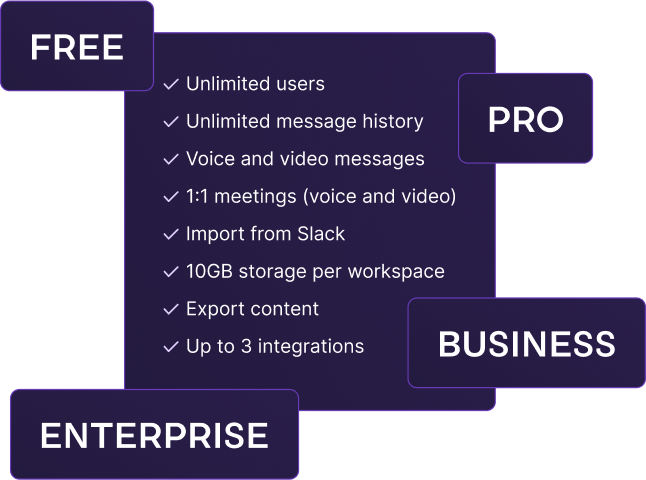Secure messaging has become one of the imperatives for any business looking to protect their data and be compliant with high security standards and specific protocols.
Using consumer-grade or improperly configured chat applications for professional communication can have significant financial and reputational risks.
To help you decide on your top business messaging app in terms of security, I’ll take a deep dive and evaluate my 8 secure messaging app picks for 2025. When picking the contenders, I paid attention to:
- User experience — the main features and upsides vs downsides of using the app for business,
- Main security features — the encryption models, compliance certifications, and administrative controls the app offered,
- Business friendliness — judging if the app is oriented towards companies or individual users, and
- Price — the most affordable plan for each of the apps.
Before we dive into the apps and their security features, let’s take a look at some specific security features and what they provide.

App security 101: Most important technical terms
In this article, I will be using certain technical terms and cover features that may not be widely familiar.
So, before we jump to the apps, let’s take a look at the basics of various security features commonly offered by top-tier business communication apps.
Hopefully, this will help you make the best choice for your business.
The most important security features of messaging apps for businesses are:
- Encryption models (most notably TLS and E2EE),
- Security compliance certifications (such as SOC 2 and ISO/IEC 27001), and
- Authentication, Authorization and Identity Management (most notably SSO, 2FA and MFA).
Encryption models
Encryption models are used to encrypt data so that it can only be accessed by the intended user. The most common encryption models for business messaging apps are:
- TLS (Transport Layer Security). All messages are encrypted in transit (while the message is being sent). Apart from the intended recipient who can decrypt the message and read it, the messages may also be accessed from the server side. This is usually only done when a company needs to give access to messages for legal reasons (e.g., a harassment case). TLS level security also allows apps to offer “global search”, allowing employees to search for files shared before they were added to the app’s workspace, and similar.
- End-to-End encryption (E2EE). All messages are encrypted by the sender and can exclusively be decrypted by the receiver. There’s no server side access. E2EE is insisted upon by companies dealing with highly sensitive data (such as governments, hospitals, etc.). The downside is that it often imposes the limitation on searching through messages for important documents or accessing chats on the server side for legal reasons, so many businesses often avoid it — for better day-to-day functionality of the app.
Security compliance certifications
Security compliance certifications represent official awards granted by accredited, independent third parties. They verify a given company’s security program and guarantee that it meets a specific, recognized standard.
The most common security certifications for business messaging apps include:
- SOC 2 (System and Organization Controls 2),
- ISO/IEC 27001,
- GDPR, and
- HIPAA.
Authentication, authorization, and identity management
For team communication apps, the most common ways of authentication and identity management are:
- SSO (Single sign-on) — a system that lets you log in with one set of credentials (e.g. accessing an app with an email account, without retyping your password),
- 2FA (two-factor authentication) — a second piece of evidence to prove your identity, such as a code from your phone or email, and
- MFA (multi-factor authentication) — potentially requiring more than 2 pieces of evidence to log in.
Top business messaging apps for security: A direct comparison
Here’s an overview of the top 8 secure business apps, comparing their main functionalities, security features, business-friendliness, and pricing side by side.
| App | User experience and main features | Main security features | Business oriented | Most affordable plan with security features |
|---|---|---|---|---|
| Pumble | – Centralized workplace organized with channels and threads – Smooth experience and great personalization – Integrated voice and video calls | – TLS in transit and at rest – Managing users and user groups – Workspace settings for users – Custom data retention policies – Role-Based Access Control (RBAC) – Channel-specific permissions | Yes | $2.49 per user per month (billed annually) |
| Microsoft Teams | – Highly customizable – Deeply integrated with the Microsoft 365 ecosystem – Slight learning curve | – TLS, limited E2EE – User, group and guest management – Granular policies for messaging, meetings, and calling – Integration with Microsoft Purview suite for advanced governance – Data Loss Prevention (DLP) – eDiscovery | Yes | $4 per user per month (billed annually) |
| Slack | – Simple to navigate – Easy to set up – Extensive integration list | – Extensive control managed through a central dashboard – Extensive compliance certifications – TLS – Slack EKM (add-on) | Yes | $7.25 per user per month (billed annually) |
| Signal | – Messenger app best for individual users – DMs, group chats, voice/video calls and other standard features | – Creating and managing groups – Mandatory “always-on” E2EE – Mandatory user-generated PIN for account recovery | No | Free |
| Wire | – Chat app/business communication crossover – Temporarily include external collaborators (without creating an account) | – Role-Based Access Control (RBAC) – Mandatory open-source E2EE | Yes | €7.45 (~$8.65) per user per month (billed annually) |
| – Essential personal utility – Business version of the app allows you to add business hours and use practical chat labels on your business profile | – No central dashboard – E2EE through Signal protocol | No | Free | |
| Telegram | – A hybrid app between a private messenger and a social media platform – The expected features of a consumer-grade messaging app, with speed as one of the main priorities | – No central dashboard – TLS – E2EE in “secret chats” | No | Free |
| Discord | – Creating servers and channels with individual users – Informal voice and video chat for quick call hopping | – TLS – Customizable user permissions within servers and channels – No central dashboard | No | $2.99* per user per month or $29.99 per user per year (billed annually) * Prices may vary depending on localized plans |
Top 8 secure messaging apps for businesses
We’ll take a look at the top 8 messaging apps with different privacy goals, and cover:
- Apps tailored to enterprise businesses (Pumble, Microsoft Teams, and Slack),
- Best apps for privacy purists (Signal and Wire), and
- Widely popular user apps (WhatsApp, Telegram, and Discord).
Let’s dive straight into the list and take a look at the business oriented apps first.
Pumble — Perfect balance between great price and strong security
User experience: Clean, reliable, easy to learn
Security: TLS in transit and at rest, ISO/IEC 27001, SOC 2, and GDPR compliance, Single Sign-on, Role-Based Access Control (RBAC)
Business oriented: Yes
Most affordable paid plan: $2.49 per user per month (billed annually)
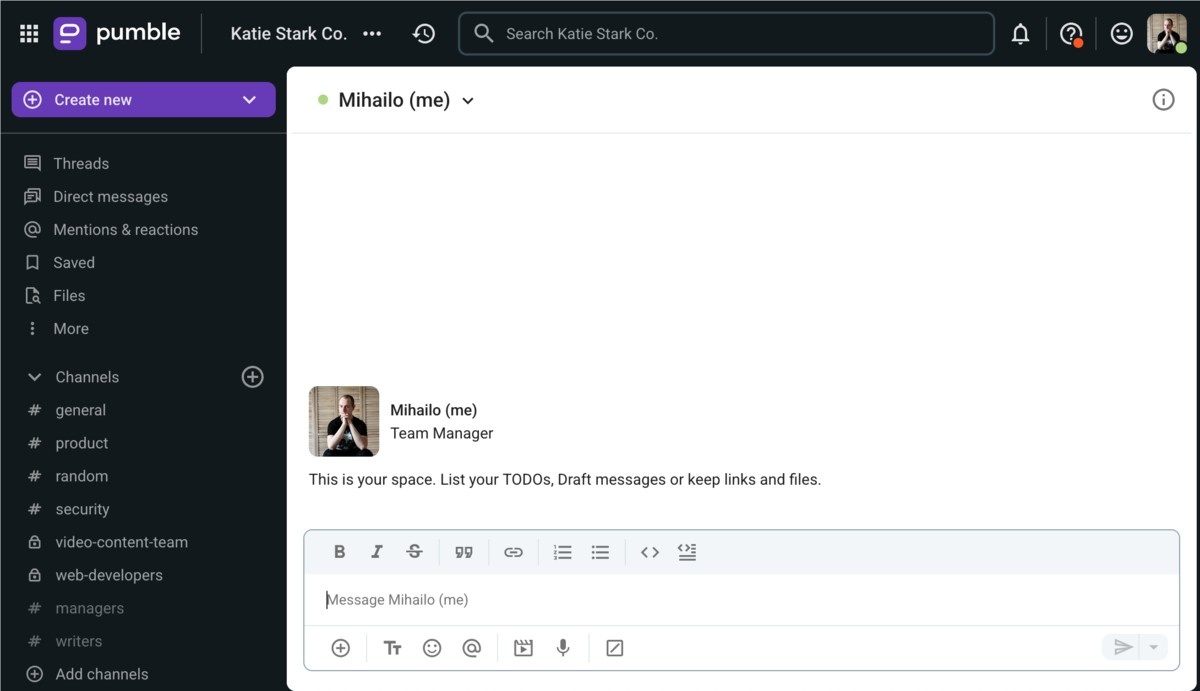
Pumble is a team communication app designed to centralize workplace collaboration by organizing conversations into channels and threads, while also offering integrated voice and video calls.
My experience with the app was smooth from the very beginning — I had no issue finding my way through the app, and the features were very easy to grasp. I also like the personalization features, like the option to arrange my workspace just the way I prefer.
In Pumble, users can, among other things:
- Set up group individual chats and channels,
- Make voice and video calls,
- Send voice and video messages,
- Set different color themes, and
- Turn notifications on or off on a per-channel basis or for the whole app.
I think it’s equally suited to remote, hybrid, and in-person environments, since it has virtually no learning curve. Pumble also offers unlimited message history on all plans, making it the best business communication app in terms of overall value.
All communication in Pumble is contained within a digital workspace, allowing administrators to set different clearance levels for different users.
Pumble uses a Role-Based Access Control (RBAC) model, which allows admins to set user permissions based on roles — a secure and scalable approach for businesses.
In Pumble, admins can:
- Control workspace settings for users (such as who can invite new members),
- Assign roles and permissions (e.g., channel owner, admin, member, or guest with limited access),
- Set channel-specific permissions (e.g., who can post), and
- Add guests to selected channels as temporary external collaborators, without them ever needing to create a Pumble account.
The app also supports SSO (Single Sign-On), allowing users to log in using their existing company credentials (such as Google Workspace or Microsoft Entra ID), eliminating the need to remember multiple passwords.
Pumble by CAKE.com provides an industry-standard encryption foundation. All data shared over the app is encrypted in transit and at rest using Transport Layer Security (TLS), which keeps your data secure while traveling over the internet and while stored on the company’s servers.
Pumble’s parent company, CAKE.com, demonstrates a strong commitment to security with key international compliance certifications: SOC 2 Type II and ISO/IEC 27001.
All in all, Pumble is a very capable, secure, and reliable business messaging platform.
Its features, along with its affordable price, empower businesses to adopt a strong security posture without the complexity and the high cost typically associated with enterprise-grade security solutions.
Run your business securely and affordably with Pumble
Microsoft Teams — Advanced, secure, and pricy
User experience: Very customizable, appealing design, but potentially disorienting and overwhelming UI
Security: TLS, limited E2EE, Extensive certifications (SOC 1, 2, and 3; ISO/IEC 27001, 27017, and 27018; HIPAA, FedRAMP), Session duration, MFA, SSO, Conditional Access policies, Role-Based Access Control (RBAC)
Business oriented: Yes
Most affordable paid plan: $4 per user per month (billed annually)
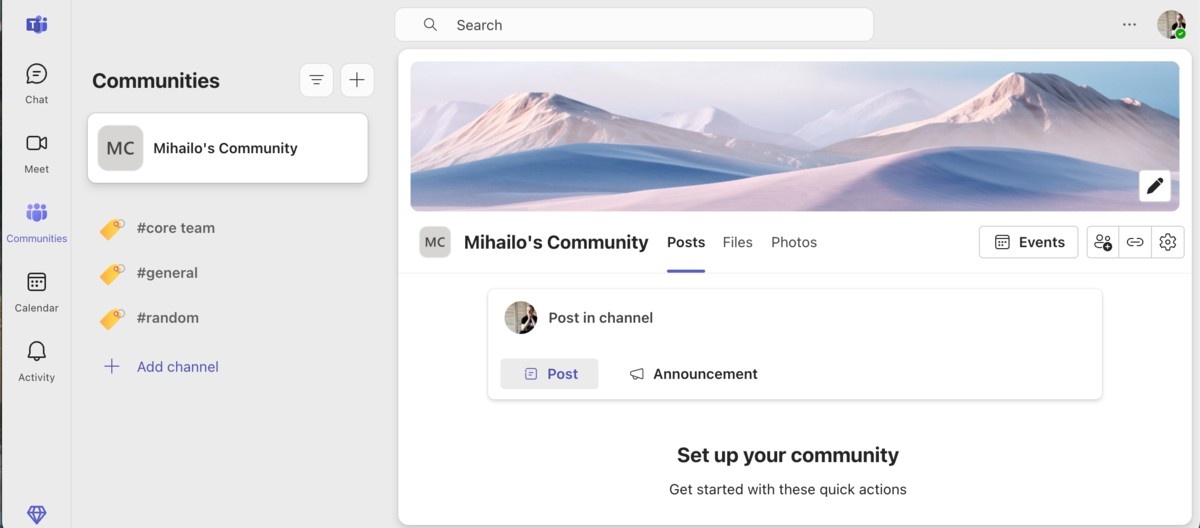
Microsoft Teams is a collaboration platform that offers channels, video meetings, communities, and file co-authoring with Microsoft 365 applications.
From an employee perspective, the app is highly customizable. I could customize everything from color themes and notifications to meeting backgrounds and status messages. I was even able to pin my most-used channels and apps to the top of the list for quick access.
Since Microsoft Teams is deeply integrated with the Microsoft 365 ecosystem, it’s often the go-to choice for teams relying on Microsoft tools such as Excel, Word, PowerPoint, etc.
For me, the biggest downside of Microsoft Teams is that its features might need a little getting used to. Expect up to a few days to adjust to the interface, as the app can get overwhelming easily, especially compared to its more streamlined competitors like Pumble.
As an admin, Teams allows you to:
- Add tabs at the top of any channel to embed other apps and services,
- Create and organize channels and communities, and
- Assign member permissions.
In terms of security, Microsoft Teams supports Single Sign-On (SSO) and basic Multi-Factor Authentication (MFA) on its entry plan.
Microsoft’s service is hosted on their cloud infrastructure, which is independently audited and certified against ISO 27001, SOC, HIPAA, and GDPR.
All data (including chats, files, and meetings) is encrypted in transit using industry-standard TLS protocol.
However, the fundamental strength of the encryption varies depending on the plan. The lowest MS Teams pricing plan starts at $4 per user per month (billed annually), while its most expensive plan — the Microsoft 365 Business Standard plan (which offers advanced security features) — costs $12.50 per user per month (billed annually).
So, Microsoft Teams falls into the category of trustworthy internal communication software, and is a reliable, albeit pricey choice.
🎓 Pumble Pro Tip
Check out our blog to see how MS Teams and Pumble stack up against each other in terms of functionality, experience, and features:
Slack — Popular, reputable, but the most expensive
User experience: Slick, reliable, leaning towards “informal”
Security: TLS, Slack EKM (add-on), Extensive security certifications, Session duration, 2FA, SSO, third-party Data Loss Prevention (DLP), and eDiscovery
Business oriented: Yes
Most affordable paid plan: $7.25 per user per month (billed annually)
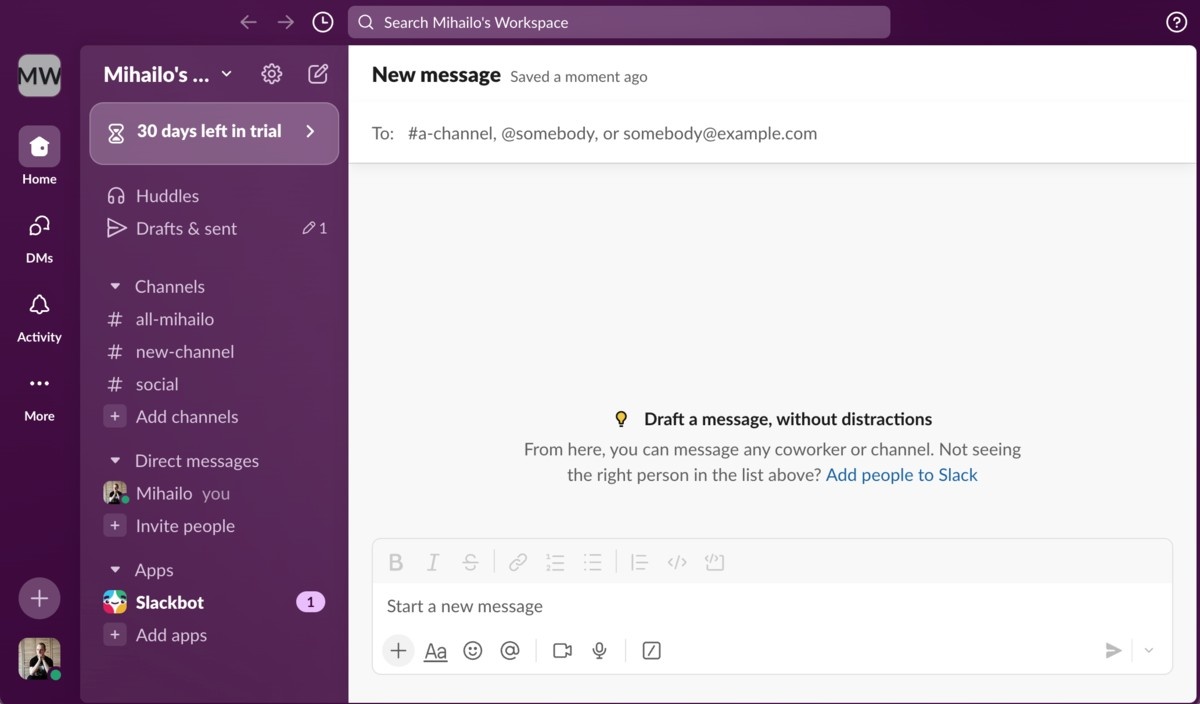
Similar to Pumble and Teams, Slack is also an intuitive channel-based messaging platform. It’s easy to learn and it allows workspace admins to manage users, channels, and user permissions.
The app is at its best when used in combination with other tools that are on its extensive integration list — which is one the app’s biggest upsides.
Its interface was simple for me to navigate, and the overall environment felt more on the informal side — especially due to its audio and video call feature (Huddles). Despite this, it still looked secure, and its security features backed this up.
Regardless of the subscription tier, Slack implements encryption (TLS) for all customer data — both the data traveling publicly and the data at rest.
However, Slack’s more advanced administrative controls such as workspace-wide policies, granular permissions, Data Loss Prevention (DLP), and eDiscovery tools, are only available on more expensive plans (the Pro and Enterprise+ plans, depending on the feature).
Slack offers a vast list of security certifications allowing specific industries to be compliant with their requirements. The most important ones are:
- SOC 2 Type II and SOC 3,
- ISO/IEC 27001, 27017, 27018,
- FedRAMP moderate authorization (for US government agencies),
- GDPR,
- HIPAA, and
- FINRA compliance support.
However, Slack’s pricing doesn’t offer much choice in terms of payment for a heavily regulated business — the Enterprise+ plan is the only option that can provide all of the necessary tools to meet high-risk and compliance obligations, with a custom and relatively expensive price.
Many of the advanced security features are only available to Enterprise+ users — the most expensive plan available for the platform with a “custom” price. For reference, the most expensive plan before the custom one is $15 per user per month (billed annually).
Try Pumble, the best Slack alternative
As far as authentication, authorization & identity management go, Slack offers Single Sign-On, 2FA, RBAC model with both predefined and customizable roles, and SCIM support — an open standard protocol designed to automate user provisioning and de-provisioning.
All in all, in terms of security, Slack is a good business-oriented platform. It offers a variety of deep administrative controls, many compliance certifications, and advanced security features, suitable for heavily regulated industries.
A big caveat here is that all of this comes at a hefty price.
After covering 3 of the most popular messaging apps tailored to businesses, let’s take a look at the best apps suited to “privacy purists”.
🎓 Pumble Pro Tip
To take a closer look into the main differences between Slack and Pumble from a user perspective, make sure to check out:
Signal — Best for individuals big on personal privacy
User experience: Straightforward, simple to use, intuitive
Security: Mandatory, “always-on” E2EE, no formal compliance certifications, intentionally minimal authentication features for personal privacy
Business oriented: No
Most affordable paid plan: It’s free.
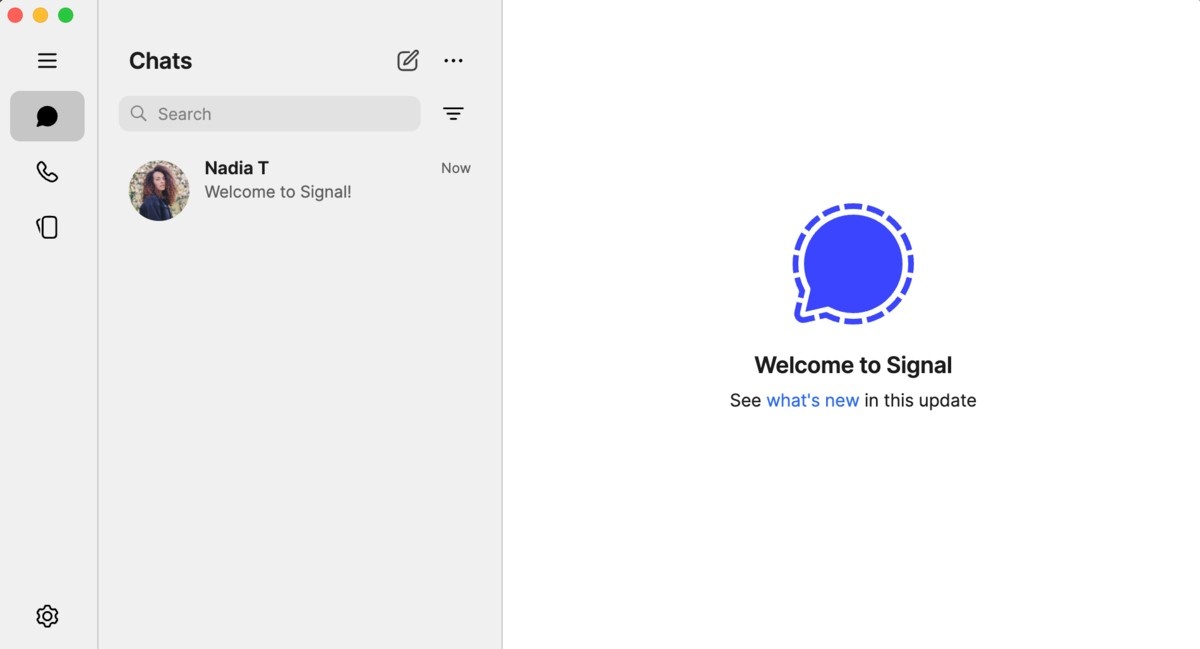
Signal is a messenger app intended for individual users. Its appeal grew steadily over the years due to its open-source nature and commitment to privacy. Significant mainstream recognition came in late 2020 and early 2021, after concerns about privacy policies of rival messaging apps were raised.
Its interface is simple enough, and does just what you would expect from a consumer-grade chat app.
To me, the app shines at its brightest when it’s used for personal day-to-day communication or secret one-on-one talks with its “disappearing messages” feature.
The user’s identity is tied to a personal phone number, and the account is secured with a user-created PIN. Within a group, its creator can add or remove members, but there are no granular, role-based permissions like RBAC.
In terms of security, which is Signal’s most talked about strength, the app uses the open source Signal Protocol to provide mandatory, always-on end-to-end encryption (E2EE).
This means that only the sender and intended recipient can ever access the content of all messages, voice calls, and video calls.
However, the central paradox of Signal is that its greatest strengths from a privacy perspective are its most critical weaknesses from the perspective of corporate risk management.
Signal offers virtually no administrative controls in a business context. While a user can create and manage a group, there are no central dashboards, data retention policies, or user management features.
The platform is designed well for peer-to-peer communication, but, unfortunately, it just isn’t suitable for corporate oversight.
Enterprise-grade controls for policy enforcement and platform oversight are completely absent. The authentication and authorization features are intentionally minimal for user privacy.
There is no central identity management or support for automated user provisioning like SCIM. Finally, there is no support for enterprise features like SSO.
All in all, Signal is a product deliberately designed for individual consumer privacy. The lack of an administrative console, user management, and no compliance certifications all imply that although Signal offers great security, the tool simply isn’t built for business organizations.
Try Pumble — a communication tool built for businesses
Wire — A good balance between security and usability
User experience: Secure, clean, professional
Security: Mandatory, open-source E2EE, GDPR, SOC 2 Type II, ISO/IEC 27001, SSO, Microsoft Entra ID (Azure AD) and Okta IdP integration, RBAC
Business oriented: Yes
Most affordable paid plan: €7.45 (~$8.65) per user per month (billed annually)
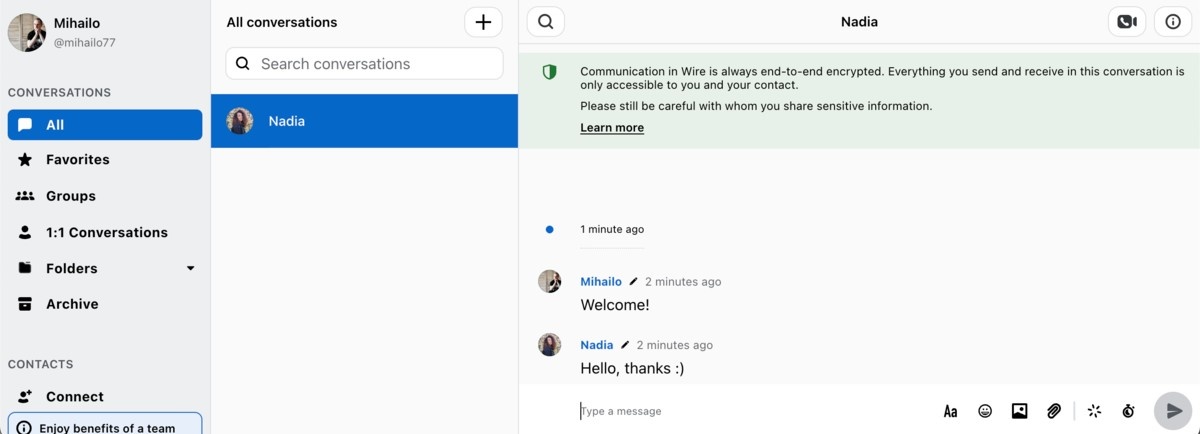
Wire is a messaging app widely recognized for achieving a strong balance between good security and a modern, user-friendly interface.
To me, it feels like a crossover between a business-grade and consumer-grade app, with a little more versatility in the ways you organize and navigate your conversations.
Apart from the basic chat and call functionalities, Wire allows you to:
- Store favorite chats,
- Archive them,
- Sort them into folders, and
- Connect with other users who sign on to the app from their email address.
Its guest feature allows you to temporarily include external collaborators, similar to Pumble.
With their Proteus protocol, Wire enforces E2EE for every single message. In addition, every message on Wire is encrypted with a new key for maximum security. The conversation history is stored locally on each user’s device, and can’t be accessed on the server.
As far as administrative controls go, Wire also allows admins to:
- Manage the full user lifecycle (onboarding and offboarding),
- Create and manage teams and user roles, and
- Set security policies, such as the “device screen lock” requirement.
Wire supports SSO and employs a RBAC model for managing user permissions and access to conversations. It also supports SCIM for automated user provisioning and de-provisioning.
Wire’s greatest downsides for the most security-heavy organizations are the lack of native 2-factor authentication and metadata sensitivity (the patterns of communication are visible to the platform operator, which may be a disqualifying factor for organizations with the most rigorous security needs).
Another important thing to watch for here is the pricing. The €7.45 (~$8.65) price per seat (billed annually) is suitable for teams of up to 100 people. After that, you’ll have to contact Wire’s sales team for a custom price.
Wire is a solid choice if your organization operates in a highly regulated industry, or it requires absolute confidentiality. However, if your priority is maximizing productivity through a seamless workflow, a more feature-rich app like Pumble is a better choice.
Super-charge team productivity with Pumble
With the “privacy purist” apps covered, let’s take a look at the widely known, but risky crossovers — WhatsApp, Telegram, and Discord.
WhatsApp — Good for external communication
User experience: Intuitive, people-oriented, consumer-grade
Security compliance certifications: E2EE through Signal protocol, no security compliance certifications, authentication through a personal phone number
Business oriented: No
Most affordable paid plan: It’s free.

Being arguably one of the most popular communication apps in the entire world, WhatsApp probably needs no introduction.
It has developed a reputation as an essential and reliable utility for personal communication.
The business version of the app, called WhatsApp Business (billed on a per-message basis), allows you to:
- Create a business profile with an address and business hours,
- Organize chats with labels such as “pending” or “resolved”,
- Set automatic replies, and similar.
In terms of security, WhatsApp provides mandatory, strong E2EE for all messages, calls, and file transfers using the highly-regarded Signal Protocol.
As far as administrative controls go, WhatsApp offers no central dashboard to manage multiple employee users, enforce security policies, or oversee communications.
Upon testing it, it was obvious to me that the app was designed primarily with one-on-one personal communication in mind, and small to medium-sized group conversations.
In terms of business use, WhatsApp can be very useful as a means to reach out and run a small business as an entrepreneur, especially if your work requires frequent one-on-one client communication.
However, as a consumer-first application, WhatsApp is simply not designed to meet the data governance, auditing, and control requirements of regulated industries — which also means no security compliance certifications for larger teams.
Finally, there is no central system for managing users or automatic account provisioning and de-provisioning, making it impossible for a business to control employee access securely. The same goes for important company information.
Overall, the business version of the app is a tool that’s very well designed for small businesses to communicate with external customers, as it can serve as a “digital storefront”. Plus, it’s quite cost-effective, especially for businesses that are just starting out.
On the other hand, due to the complete lack of administrative controls, compliance certifications, and identity management features, it might not be the best choice for medium or large companies.
Handle complex communication challenges easily with Pumble
Telegram — Optional E2EE WhatsApp alternative for individual users
User experience: Minimalist approach, user friendly, consumer grade
Security: TLS, E2EE in “secret chats”, no compliance certifications, authentication through a personal phone number
Business oriented: No
Most affordable paid plan: It’s free.

Telegram is a messaging app that feels like a fast and feature-rich hybrid between a private messenger and a social media platform.
It offers all the expected features of a consumer-grade messaging app, such as messaging, calls, creating group chats, calling other users, sharing files, and chat search. To me, it feels more focused on speed, customization, and large-scale community features than WhatsApp.
It even evokes a sense of being a ‘power-user’ tool, especially when we take into account Telegram’s strong stance on privacy and freedom of speech.
To achieve maximum security for its users, Telegram’s chats use client-server encryption (TLS) as a default, with E2EE available as an optional feature called “Secret Chats”. They are limited to one-on-one conversations, and they do not sync across devices.
However, group chats and channels are never end-to-end encrypted.
As far as businesses are concerned, Telegram offers controls for managing communities, but isn’t very suitable for managing a large corporate workforce. In groups and channels, admins can:
- Add or remove members,
- Set granular permissions (control what content members can post),
- Manage chat history, and
- Pin messages.
However, Telegram offers no central dashboard for a business to manage multiple employee accounts.
This means that a business cannot enforce security policies or oversee company-wide data, which is a major downside for business use. Same as with WhatsApp, SSO is not supported in Telegram.
Permissions are limited to group and channel administration (e.g., the ability to ban users) and there is no central system for a business to manage employee identities or automate account provisioning and de-provisioning.
Similar to WhatsApp, user identity is tied to a phone number, though Telegram also allows its users to create a public username.
Although Telegram’s powerful channel and group features are often used by businesses for community engagement, this tool is still a consumer messaging app in essence.
In my opinion, Telegram can be more than sufficient for micro-sized or small teams and companies in need of a fast messaging app with a minimalist design. Backed with strong E2EE and personal data protection, it could be a solid choice — if access to all messages after a team member leaves the company is not of utmost importance.
On the other hand, the absence of any corporate compliance certifications and the complete lack of enterprise identity management tools make it unsuitable and insecure for internal business collaboration where security and compliance are a priority — especially for medium and large teams.
Discord — Solid user controls good for personal use
User experience: Casual, customizable, not really private
Security compliance certifications: TLS, no security compliance certifications, 2FA, RBAC
Business oriented: No
Most affordable paid plan: $2.49 per user per month (billed annually)
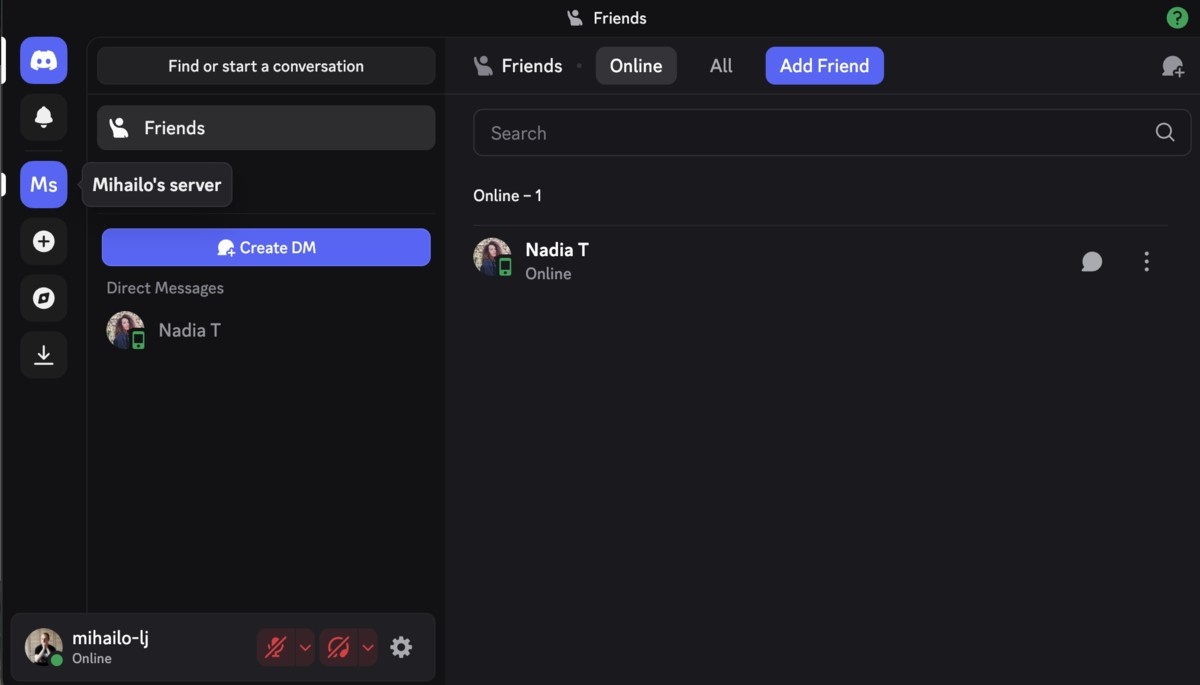
Discord is a community chat platform organized into servers, best known for a unique blend of text channels and “drop-in” voice channels that create a social hangout space.
I’d describe Discord’s vibe as informal and community-driven — which is either the best thing or the worst thing about it, depending on your team’s size and workplace culture.
The biggest reasons for Discord’s popularity are its high-quality audio calls and seamless server and channel hopping experience. For some users this is a standout feature, because it allows people to always be connected while collaborating. In a business setting, users often make use of this by being muted while working and unmuting themselves when they need to ask someone a question.
Discord allows admins to create servers with a detailed hierarchy and specific permissions. This gives server owners the opportunity to control everything from someone’s ability to speak in a channel, all the way to sending messages, or allowing other users to manage server members.
However, fundamentally, these controls are designed for online communities, not a corporate environment. Like the two previous consumer-grade apps I mentioned, Discord doesn’t have the central dashboard to manage multiple servers under one business profile.
Discord does support a strong 2FA, but it does not support enterprise SSO. Also, there is no support for automated user provisioning and de-provisioning.
Despite the powerful role and permission system, Discord is fundamentally still a consumer and community platform.
Stay compliant and secure — choose Pumble for your team communication
The absence of any business compliance certifications and the inability to integrate with enterprise identity systems make it mostly unsuitable and insecure for confidential internal business communication of medium and large teams. On the other hand, I can see how small teams with a casual work ethic could enjoy the benefits of the laid back design and feel.
Concluding our list with 3 consumer-grade apps, it’s important to note that using these types of tools for business purposes creates what is known in the IT world as Shadow IT, specifically because of the lack of data control.
This practice is considered a significant security risk not because the apps themselves are inherently malicious, but because they fail to deliver the fundamental requirements of a corporate environment. Keep that in mind when choosing a tool based on security for your business.
🎓 Pumble Pro Tip
Check out a direct comparison of Discord and Pumble for team communication:
Ensure strong business security and compliance with Pumble
If you’re looking for a reliable security communication app, look no further than Pumble.
Pumble’s main security foundation rests on data encryption both in transit and at rest, and third-party validation through its parent company, CAKE.com, which holds SOC 2 Type II and ISO/IEC 27001:2022 certifications.
Through the all-round TLS implementation, Pumble ensures a fundamental level of security for all users, regardless of their subscription, without requiring any action on the users part.
Pumble also offers a wide set of granular permissions that allow for the fine-tuning of your workspace environment. These settings give administrators control over a wide range of actions, including individual permissions to:
- Use broad notification mentions,
- Invite new members into the workspace,
- Manage channels (create, archive, and remove members),
- Create and manage user groups, and
- Edit and delete messages.
Paired with the unlimited message history on all plans, Pumble provides the perfect balance between security, usability, and price.
Check out CAKE.com trust center to learn more about the company’s dedication to security for all users.
How we reviewed this post: Our writers & editors monitor the posts and update them when new information becomes available, to keep them fresh and relevant.

